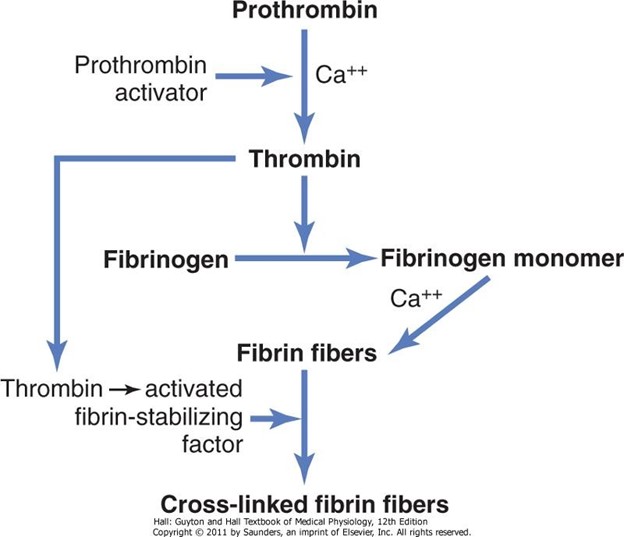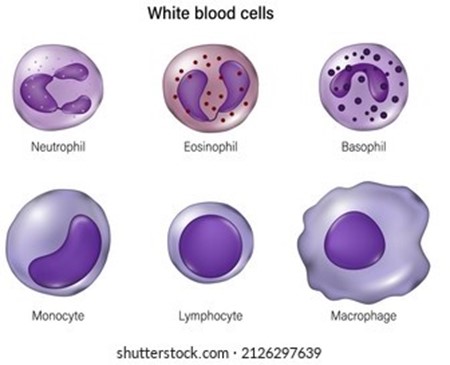The basic event in the formation of a blood clot is the change of:
Thrombin to prothrombin.
Fibrinogen to fibrin.
Vitamin K to prothrombin.
Fibrin to fibrinogen.
The Correct Answer is B

This is because fibrinogen is a soluble protein in the blood plasma that is converted to insoluble fibrin strands by the enzyme thrombin during blood clotting. Fibrin forms a mesh-like network that traps platelets and other blood cells to form a clot.
Choice A is wrong because thrombin is not converted to prothrombin, but rather prothrombin is converted to thrombin by another enzyme called prothrombinase.
Choice C is wrong because vitamin K is not converted to prothrombin, but rather vitamin K is required for the synthesis of prothrombin and other clotting factors in the liver.
Choice D is wrong because fibrin is not converted to fibrinogen, but rather fibrinogen is converted to fibrin as explained above.
Normal ranges of fibrinogen in the blood are 200 to 400 mg/dL.
Normal ranges of prothrombin time (a measure of how long it takes blood to clot) are 11 to
13.5 seconds.
Nursing Test Bank
Naxlex Comprehensive Predictor Exams
Related Questions
Correct Answer is C
Explanation
This type of blood cell is a granulocyte that has a bi-lobed nucleus and red granules in the cytoplasm.

Eosinophils are involved in allergic reactions and parasitic infections.
Choice A is wrong because basophils are granulocytes that have a lobed nucleus and dark blue or purple granules in the cytoplasm.
Basophils are involved in inflammatory responses and histamine release.
Choice B is wrong because lymphocytes are agranulocytes that have a large round nucleus and a thin rim of cytoplasm.
Lymphocytes are involved in immune responses and produce antibodies.
Choice D is wrong because monocytes are agranulocytes that have a kidney-shaped nucleus and a pale blue cytoplasm.
Monocytes are involved in phagocytosis and tissue repair.
Choice E is wrong because neutrophils are granulocytes that have a multi-lobed nucleus and pale pink granules in the cytoplasm.
Neutrophils are involved in bacterial infections and inflammation.
Correct Answer is A
Explanation
The mitral valve lies between the left atrium and left ventricle and prevents the regurgitation of blood from the ventricle back into the atrium.

It has two leaflets that open and close to allow blood to flow from the lungs into the left atrium and then to the left ventricle.
Choice B is wrong because the tricuspid valve lies between the right atrium and right ventricle and prevents the regurgitation of blood from the ventricle back into the atrium.
It has three leaflets that open and close to allow blood to flow from the body into the right atrium and then to the right ventricle.
Choice C is wrong because the pulmonary valve lies between the right ventricle and the pulmonary artery and prevents the regurgitation of blood from the artery back into the ventricle.
It has three leaflets that open and close to allow blood to flow from the right ventricle to the lungs, where it picks up oxygen.
Choice D is wrong because the aortic valve lies between the left ventricle and the aorta and prevents the regurgitation of blood from the aorta back into the ventricle.
It has three leaflets that open and close to allow blood to flow from the left ventricle to the rest of the body.
Whether you are a student looking to ace your exams or a practicing nurse seeking to enhance your expertise , our nursing education contents will empower you with the confidence and competence to make a difference in the lives of patients and become a respected leader in the healthcare field.
Visit Naxlex, invest in your future and unlock endless possibilities with our unparalleled nursing education contents today
Report Wrong Answer on the Current Question
Do you disagree with the answer? If yes, what is your expected answer? Explain.
Kindly be descriptive with the issue you are facing.
